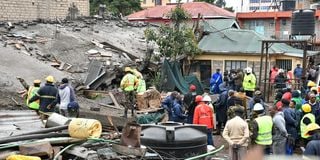Inspect all buildings, demolish shaky ones

Personnel from the Disaster Response Unit search for survivors in the Ruaka building collapse on November 17, 2022.
In recent years, there has been an increase in the number of storeyed buildings that have collapsed, mostly while under construction, and especially during the rainy season. Many of these incidents cause injury and death.
In a recent incident, a six-storey building collapsed at Ruaka in Kiambu County, killing three people. Days earlier, another had collapsed in Kasarani, Nairobi killing three.
At the weekend, some 50 households, or almost 200 people escaped death when Kiambu Governor Kimani Wamatangi ordered their evacuation from a residential flat in Ruiru before it collapsed.
Barely two months ago, a storeyed building collapsed in Kirigiti, Kiambu, killing five people.
Soon after the Ruaka accident, Governor Kimani Wamatangi disbanded the technical committee responsible for qualifying the construction of buildings. In neighbouring Nairobi, Governor Johnson Sakaja reconstituted the Nairobi City County Planning Technical Committee. The two county bosses attributed their actions to the failure of the committees to deliver on their mandate.
Justice
The duo, though in different locations, further assured the public that justice would be served to the victims.
Lives have, however, already been lost. But the dead cannot be brought back to life by arraigning people in court. The owners of the collapsed buildings, just like in the past, could be acquitted for insufficient evidence after years of long court processes in the pursuit of justice for the victims.
Disbanding or reconstitution of planning committees may not give Kenyans assurance as regards the safety of storeyed buildings. The collapses are not a new thing; they are recurrent.
An audit of all storeyed buildings in the country regarding their safety should be conducted and all those found to be unsafe brought down to avert the danger of loss of lives following their ultimate collapse.
Continuous assessment of the progress of construction by the concerned authorities could also be a remedy. The officials would make recommendations on what should be done to correct errors during construction and not wait for the building to be occupied and collapse on tenants.
The officials concerned should be transparent and have integrity so as not to compromise the assessment of buildings.
A multi-agency examination committee should be established and mandated with verifying the safety of storeyed buildings by ensuring that they meet the standards before being rented out for occupation.
Both the national and county governments should move with speed and develop mechanisms towards the safety of all storeyed buildings countrywide.
Dominic Mwangi, Nakuru




